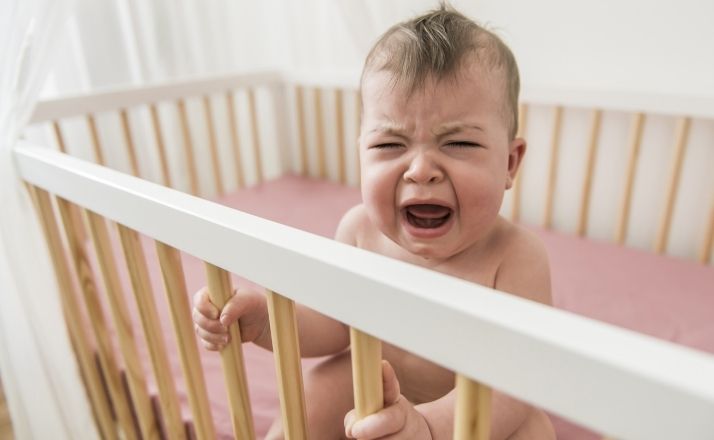Nearly every parent understands the sleep challenges of early childhood. Ask a great-grandmother in her eighties, and she can likely still recall some of those sleepless nights with her own infants.
While every baby is different, and each parenting experience is unique, there are certain ages where sleep struggles tend to happen. Knowing what those sleep regression ages are can help you be prepared when those sleepless nights strike!
What is sleep regression?
Sleep regression is a change in a baby’s sleep patterns. This could look like resisting going to sleep in the first place (either for naps or at night). Most often, it looks like Baby frequently waking during the night, even if he or she had been successfully sleeping longer stretches prior to the regression.
It’s not really considered a sleep regression if your baby has never slept well and that just continues to be the case. That’s a different level of suffering, and you have my condolences if you’re experiencing it.
When does sleep regression happen?
According to Medical News Today,
“While there is not much published research on infant sleep regressions, the general consensus among sleep specialists is that there are roughly six stages: when the baby is 4 months, 6 months, 8 months, 12 months, 18 months, and 2 years old.”
Reading that might cause you a bit of panic. After all, with that many sleep regression ages, it doesn’t seem to leave much room for normal sleep in Baby’s first two years.
The good news is that these sleep regressions don’t necessarily have to last a long time. Sometimes it’s just a few days, with others it may be a few weeks.
The first big sleep regression: 4 months
This post contains Amazon affiliate links. If you click on a link, Filter Free Parents may receive a commission. See our full disclosure policy HERE.
The four-month sleep regression is typically the first major recognized sleep regression. This is important because it sets the stage, so to speak, for the other sleep regression stages.
If you handle the sleep regression at this age well, you can set yourself up for a better chance of success with future regressions
You can learn this lesson from me. I failed the sleep regression at this age big time. I resumed rocking my baby back to sleep and I went back to feeding him in the middle of the night. Eventually, I even gave up and brought him into our bed.
All of those became semi-permanent habits because I created negative sleep associations I was unwilling to break later.

Tips for creating positive sleep associations (and avoiding negative ones)
If you don’t want to make the same mistake, follow Linsey Hennigar’s advice. As a Certified Infant and Child Sleep Consultant, she recommends:
- Putting baby to bed drowsy rather than letting them fall asleep in your arms
- Patting baby gently to sleep, while baby is lying in the crib.
- Using lightly weighted sleepwear (like these!) to provide added comfort.
The other sleep regression ages and stages
Babies tend to experience sleep regressions at ages when they’re experiencing other developmental leaps as well.
For example, the 6-month sleep regression is an age where many babies are rolling, scooting, and crawling.
Sleep regressions around ages 12 and 18 months often coincide with when babies are learning to walk and talk.
Regardless of the age or stage when sleep regression happens, the tips from sleep experts remain the same: follow healthy sleep habits, be consistent, and eventually, your child will go to sleep and stay asleep!











